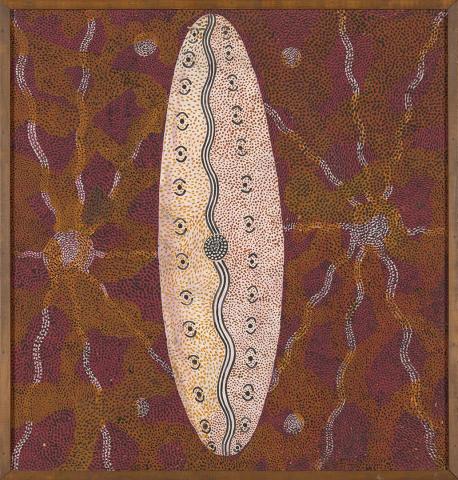Bushfire Corroboree
Papunya boards January 2021
Tim Leura Tjapaltjarri’s Bushfire Corroboree 1973 shares a multitude of narratives with its journey lines, yam plants, campfires, and central object encircled by hazy bushfire. This above and below ground depiction uses ‘washovers and other techniques like dotting onto wet grounds to obtain atmospheric effects of smoke, cloud and light which suggested [the artist’s] prior acquaintance with watercolour as a medium.’1
According to John Kean, former Art Advisor at Papunya from 1977–79, the work has been incorrectly attributed as Clifford Possum Tjapaltjarri’s Yam Dreaming in the 2004 publication Papunya: A place made after the story: The beginnings of the Western Desert painting movement.2 Here, the work is described in terms of its formal elements:
Strict symmetry has been achieved in this yam design; the central oval shape is possibly a shield with markings indicating many men sitting down, on both sides radiating undulating lines moving from centres are stylisations of the yam plant. This Dreaming is embellished with the dotted and broken-coloured backgrounding characteristic of this artist.3
What Bardon describes as a ‘central oval shape’ has been a symbol of contention for the work as it is embroiled in the early discussions among Papunya artists on whether and how to depict elements of ceremony, including the secret and sacred. In the case of this work; however, Kean maintains that:
Papunya Tula Artists documentation prepared by Peter Fannin suggests that the attenuated white oval represents a ‘churinga’ (sacred object). While the explicit representation of sacred objects in paintings by Papunya artists had been commonplace in the founding year of the painting movement, such references had become the exception by September 1973 when this work was painted. At the time, Leura was engaged in discussion about the representation of ‘restricted’ aspects of men’s ritual, suggesting that the decision to feature a churinga in this artwork was very deliberate (Kimber, 1986 & 1995).4
Bushfire Corroboree 1973 is a spectacular work in which Tjapaltjarri has demonstrated both his masterful brushwork and great ability at composing forms. The technical proficiency which Tjapaltjarri has handled the red and orange tonal qualities of the paint in particular, has created a brilliant shimmering representation of the powerful bushfire ceremony that conveys his brilliantly conveys his deep insight into his subject.
Endnotes
- Vivien Johnson, Lives of the Papunya Tula Artists, IAD Press, Alice Springs, 2008, p.46.
- John Kean, ‘Ian Rogers Collection of Early Paintings from Papunya’ [unpublished report], 2014–15, p.22.
- Geoffrey Bardon and James Bardon, Papunya: A place made after the story: The beginnings of the Western Desert painting movement, Miegunyah Press, Carlton, 2004, p.314.
- John Kean, p.22.
Connected objects
Metadata, copyright and sharing information
About this story
- Subject
